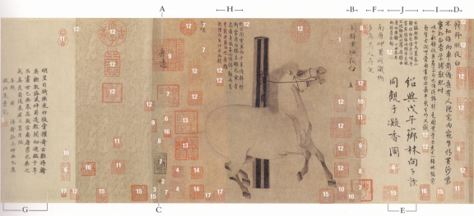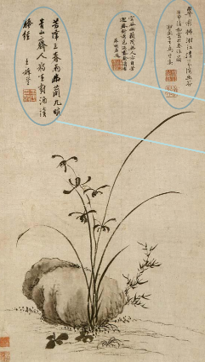Lecture 8: How to read Chinese Painting
1/5
There's no tags or description
Looks like no tags are added yet.
Name | Mastery | Learn | Test | Matching | Spaced |
|---|
No study sessions yet.
6 Terms
Misconceptions about Chinese Art
Chinese art is only painting
Sculptures exist
Chinese Art lacks naturalistic expression
Due to nature of mediums (ink & paper)
BUT naturalistic Chinese art does exist
e.g. Sketches of Birds and Insects (ca. 903-965), Huang Quan
E.g. Very small scale yet contains intricate detail
= demanded close observation to record likeness realistically
Some Chinese Art was fundamentally naturalistic BUT in the immense extent of detail they depicted, became less convincing
E.g. The Water Mill (section) (ca. 970), unknown artist
Handscroll, ink and colors on silk
E.g. use of linear perspective, representation of 3-dimensional spaces, believable sense of depth
Conversely, many Western art movements were NOT naturalistic
E.g. Impressionism (late 19th century)
E.g. Abstract Expressionism (mid 20th century)
Were these fragmentary similarities sufficient to form a coherent movement?
Yes, because such artists in China received both great acclaim & criticism
Deng Chun (1167): “(such paintings) reach the point where no recognizable forms emerge at all’
‘People react to them by saying derisively, “All an artist has to do is cut off a few feet of black silk and hang it on the wall, and he’s on his way to fame.”’
= significant no. of records about such artists, suggesting there was a significant no. of them/their influence was great
There was a lack of public spaces for the display of Art in China
The nature of Art was entirely different in China
E.g. Many Chinese artworks were portable (scroll paintings)
Easy transportation facilities wide viewership
The modes of viewing art were entirely different in China
Did not necessitate public spaces for the display of Art
Instead, the viewing of art happened in more private settings
There was a lack of woman artists in China
In fact, female artists e.g. Ma Shouzhen received wide acclaim
The extension of Chinese scholarly painting through time & space
Through collaborative additions by:
Artist
Recipient(s)
Collector(s)
Literature/handwritten text (colophons)
(a) Can provide greater context for the artwork
E.g. Shen Zhou (1427-1509)
(b) Can be a means of indicating ownership
E.g. Orchid and Rock (1572), Ma Shouzhen
Bears colophons & seals by both artist, recipient, & collector
(c) Calligraphy as a pictorial art
Skillful calligraphy & poetry was also another way through which the artist could demonstrate his talents
Artists less skilled in this area would simply include less calligraphy/none at all
Seals
Used on objects to establish personal identification
With ink (unlike wax seals in the West)
E.g. Night White (742-756), Han Gan

Night White (742-756), Han Gan
Original painting was only the piece in the middle
Paper was extended on the sides to accommodate seals & colophons
= the painting physically changes
As a collector, you definitely had the right to leave your seal
In this case, the collector was a King
The same person could have multiple different seals (all of which he could use)
Every time they opened the painting, they commemorated the experience/occasion of viewing the painting through the stamping of a seal ⭐
= multiple different seals from the same person
Depending on your status (or what you perceived your status to be), you would position your colophon/stamp differently
E.g. very near the actual illustration
Seals can be used to certify authenticity, boosts value of work
People would bring works to connoisseurs/authenticators and have them stamped
Western & Chinese parallels
Abstract Expressionism
Jackson Pollock (20th century)
Known for:
(1) Drip technique: spontaneity, free movement
(2) Alcoholism
Form > content
Wang Mo (ca. 9th century)
‘In his nature, Wang Mo was rude and wild and he loved wine. Whenever he was about to paint a hanging scroll, he would first drink, and after he was drunk, then he would take ink and splash with it.’
Zeren (ca. 10th century)
The monk Zeren […] was a habitual wine-bibber, whenever he got drunk, would splatter ink onto silk or a white-washed wall.’
‘When he sobered up, he would add and fill in (until there were) a thousand shapes and forms of the most extraordinary sort…Painters all paid homage to his inspired brush.’ ⭐
Western & Chinese parallels
Impressionism
Monet (late 19th-early 20th century)
Talking about the fog in London: ‘How could the English painters of the 19th century paint brick by brick? Those people painted bricks that they did not see, that they could not see!’
Capturing atmospheric essence > exact mimesis
Goal was anti-mimesis
What is expressed on the surface of the painting > Content
Su Shi (11th century)
‘If anyone discusses paintings in terms of formal likeness (realistic representation), his understanding is close to that of a child.’
Capturing essence > exact mimesis

Orchid and Rock (1548-1604), Ma Shouzhen
Colophons & seals by both artist, recipient, & collector
Woman artist
There was likely a market for her works given that a collector stamped it